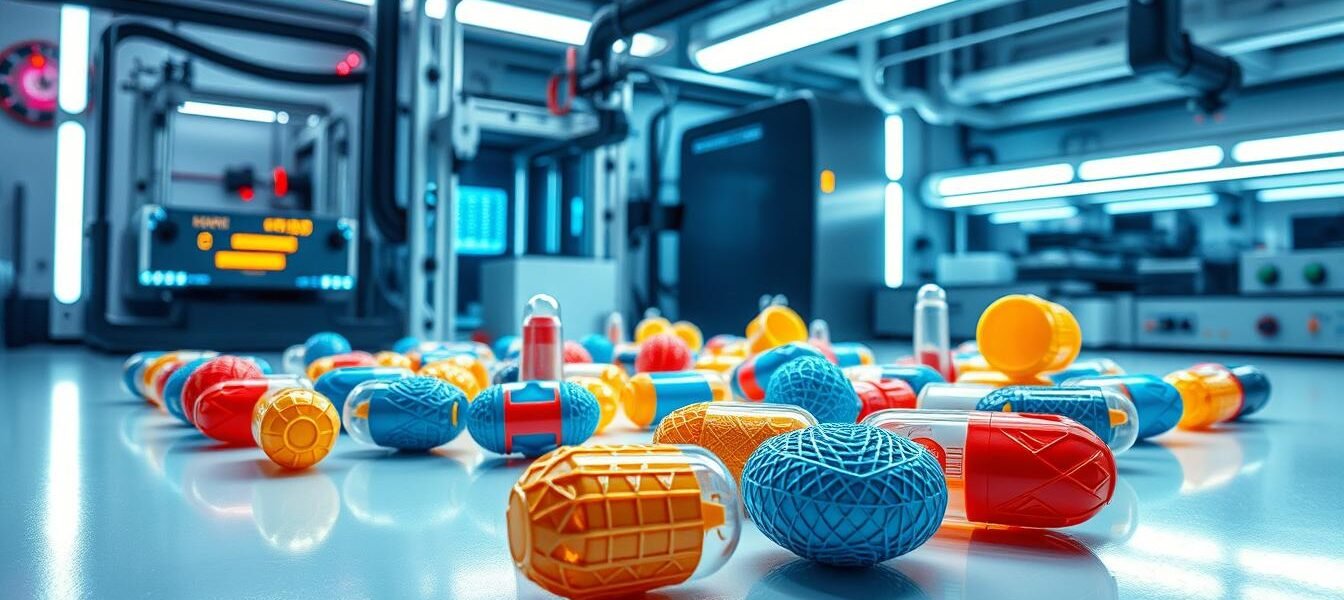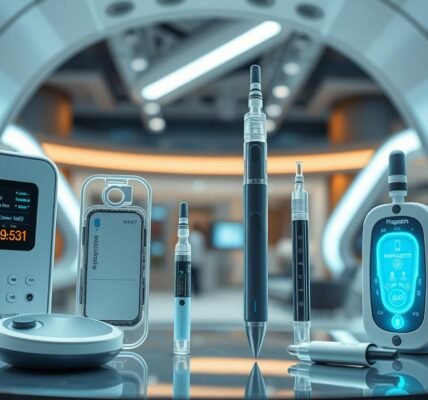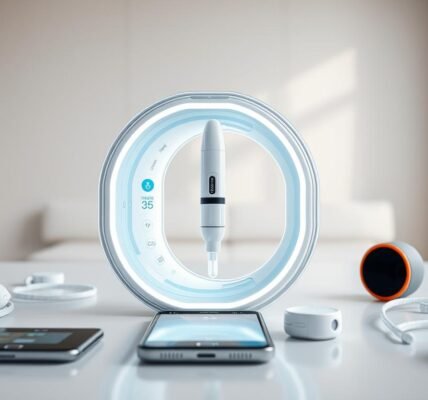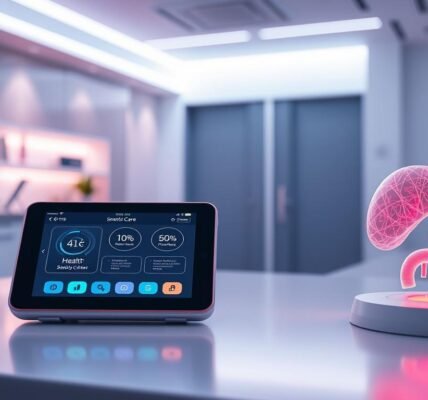The medical world is always changing, and 3D-printed insulin capsules are leading the way in diabetes treatment technology. This piece explores how 3D-printed insulin capsules could change the game. It shows how they might make old ways of treating diabetes seem outdated.
By looking into personalized medicine, we see how these capsules can meet each patient’s needs. This opens up a new world in innovative medication delivery. With new tech, the future of managing diabetes looks bright. For more on this topic, check out this in-depth study1.
Key Takeaways
- 3D printing technology is reshaping diabetes management.
- 3D-printed insulin capsules enable personalized medication delivery.
- Enhanced patient compliance through tailored dosage forms.
- Fused Deposition Modelling (FDM) is a common 3D printing method.
- Exploration of various pharmaceutical formulations highlights innovation.
Introduction to 3D-Printed Insulin Capsules
The rise of 3D printing has changed pharmaceutical technology a lot. It’s especially true for making insulin capsules. This new method lets us create medicines that fit each person’s needs.
With 10.5% of people aged 20–79 having diabetes, the need for new ways to manage it is clear2. By 2045, one in eight adults will have diabetes. This shows a big health problem that affects healthcare a lot2.
3D printing makes it possible to create medicines with exact dosages and complex designs. Methods like Fused Deposition Modeling (FDM) and Stereolithography (SLA) are great for making insulin capsules. They can help patients get better faster.
Using advanced methods, we can make medicines just for each person. This is key for better treatment and results2.Learn more about 3D printing in
The Rise of 3D Printing in Pharmaceutical Technology
The world of pharmaceuticals has changed a lot, thanks to additive manufacturing. In recent years, 3D printing has helped create custom drug delivery systems. These systems meet the specific needs of each patient. This change has led to a big jump in research, with more studies on 3D printed medicines.
By 2017, there were 77 studies on 3D printed medicines, up from 59 in 2012. The number of times these studies were cited also skyrocketed, from 209 to 12,4113.
The FDA approved the first 3D printed drug in 2015. This was a big step for pharmaceutical innovation. It showed how 3D printing could change the industry4.
Now, 3D printing is used to make different types of drugs, like tablets and implants. These are made using special 3D printing methods. This technology helps create medicines that fit the needs of each patient, like children and the elderly5.
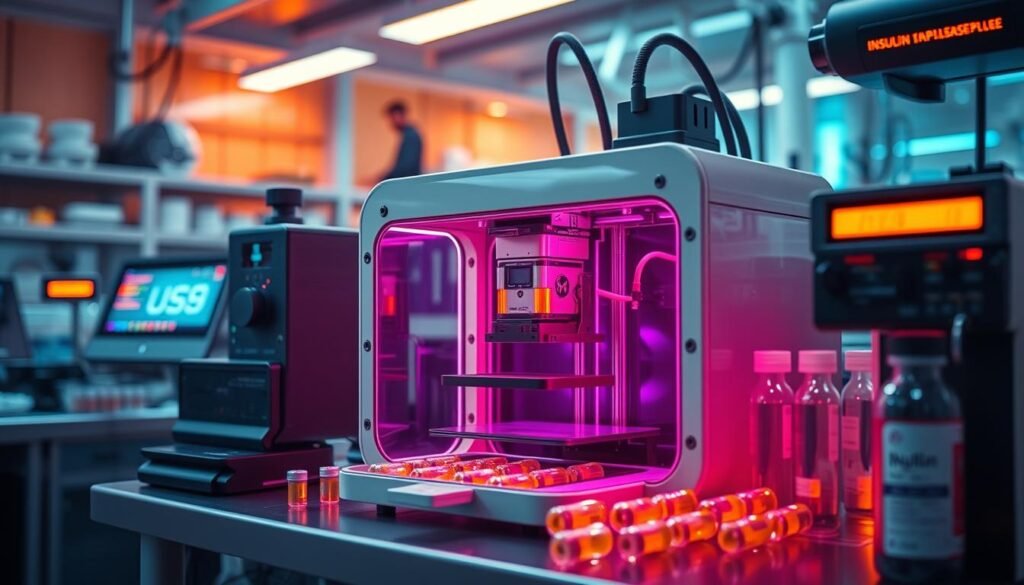
Since 2016, over 3,700 papers have been published on 3D printed medicines. This shows how much support there is for this technology5. Using 3D printing in drug development saves time and money. It also makes personalized treatments that meet specific medical needs5.
As more research and investment come in, the future looks bright. We can expect better care for patients with medicines made just for them.
| Year | Number of Publications | Citations |
|---|---|---|
| 2012 | 59 | 209 |
| 2017 | 77 | 12,411 |
Understanding Traditional Insulin Delivery Methods
Traditional insulin delivery methods include injections and insulin pens. These methods have been around for decades but have their limits. They can affect how well patients manage their diabetes.
Limitations of Conventional Insulin Delivery
Conventional insulin delivery has its downsides. Patients often face unpredictable blood sugar levels due to how insulin is absorbed. The pain from injections can also make it hard for people to stick to their treatment plans.
Getting the right dose of insulin can be tricky. This can make managing blood sugar even harder. With over 500 million people worldwide living with diabetes, finding better ways to deliver insulin is key.
Patient Compliance Issues
Getting patients to follow their treatment plans is a big challenge. This is especially true for traditional insulin delivery methods. In the U.S., around 37 million people have diabetes, making it urgent to find ways to improve adherence.
About 20-30% of Type 2 diabetes patients are on insulin. Yet, many struggle to keep up with their treatment. The discomfort and inconvenience of traditional methods are major barriers. As diabetes care evolves, finding ways to improve patient compliance is essential.
What Are 3D-Printed Insulin Capsules?
3D-printed insulin capsules are a big step forward in medicine, especially for diabetics. They are made layer by layer with advanced 3D printing. This method lets doctors control how much medicine is released.
The way they’re made uses biocompatible materials. These materials are safe and help the medicine work right.
Technological Overview of 3D Printing
3D printing builds things from the bottom up. It uses a method called Fused Deposition Modeling (FDM). This method melts plastic to make objects layer by layer.
This is great for making insulin capsules that fit each patient’s needs. New methods, like co-axial 3D bioprinting, let us print with different materials at once. This opens up new ways to deliver medicine.
Materials Used in 3D Printed Capsules
The materials used in capsules are key to how well they work. Scientists have made special materials that work really well, up to 98% pure6. These materials can be mixed with others for even better results.
By using these materials, doctors can make capsules that release medicine just right for each patient. This helps patients stick to their treatment plans better. It also makes the medicine work better.
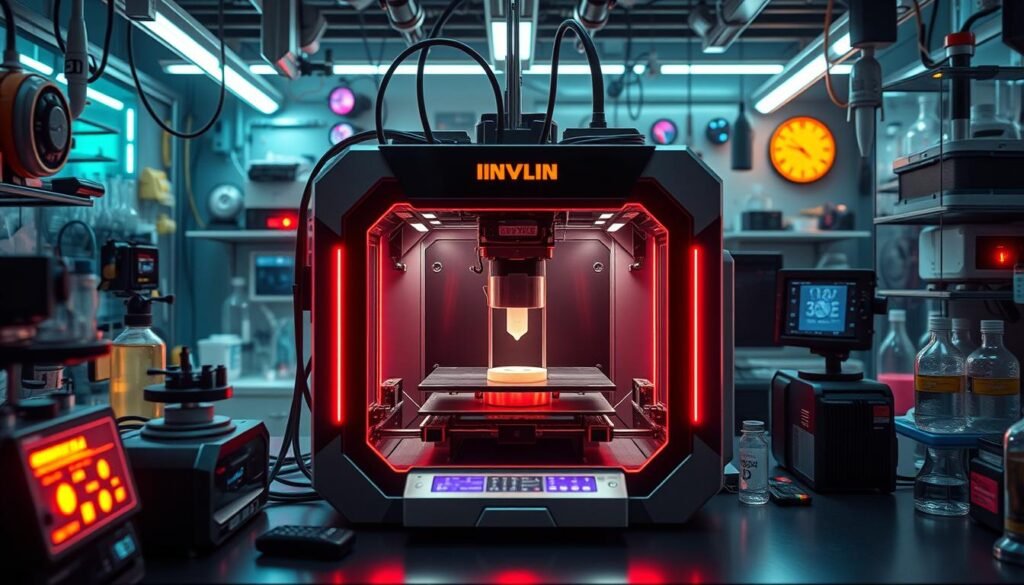
Benefits of 3D-Printed Insulin Capsules
The benefits of 3D printing are changing how we get medicine, especially insulin. It lets us make doses just right for each person. This makes treatment safer and more effective.
These capsules also help avoid mistakes with medicine. They are made just for you, which is safer.
Another great thing is how 3D printing can change how medicine is released. It can be slow or fast, depending on what the patient needs. This is better than old ways that don’t fit everyone.
More doctors are starting to like 3D printed tablets because they are made just for you7. This shows they are open to new ways to help patients.
Also, people are more likely to stick to their treatment when it’s made for them. This makes them trust their doctors more. And that leads to better health.
In short, using 3D printing for insulin is very promising. It makes medicine more personal and could save money. This is a big step towards better healthcare for everyone8.
Personalized Medicine and 3D Printing
The healthcare world is changing fast. Now, personalized medicine and 3D printing are key. They help make treatments that fit each patient’s needs better. This means treatments that consider a patient’s age, health, and genes.
Custom Dosage Forms
Custom dosage forms are a big step forward. Aprecia Pharmaceuticals created ZipDose Technology. It makes tablets that hold up to 1,000 mg of medicine and dissolve quickly9. This means treatments can be made just right for each person.
3D printing also lets us make medicines in different ways. We can make solid or liquid medicines as needed10.
Patient-Specific Treatments
Patient-specific treatments are changing how we take medicine. FabRx’s M3DIMAKER lets us make personalized Printlets. These can have special shapes, flavors, and doses9.
This is great for people who have trouble swallowing pills or need special medicines. 3D printing also makes polypills. These are pills with many medicines in one, making it easier to take medicine10.
Personalized medicine is more than a trend. It’s about understanding how our genes and lifestyle affect how medicines work11. 3D printing is key in making treatments that really fit each patient’s needs.
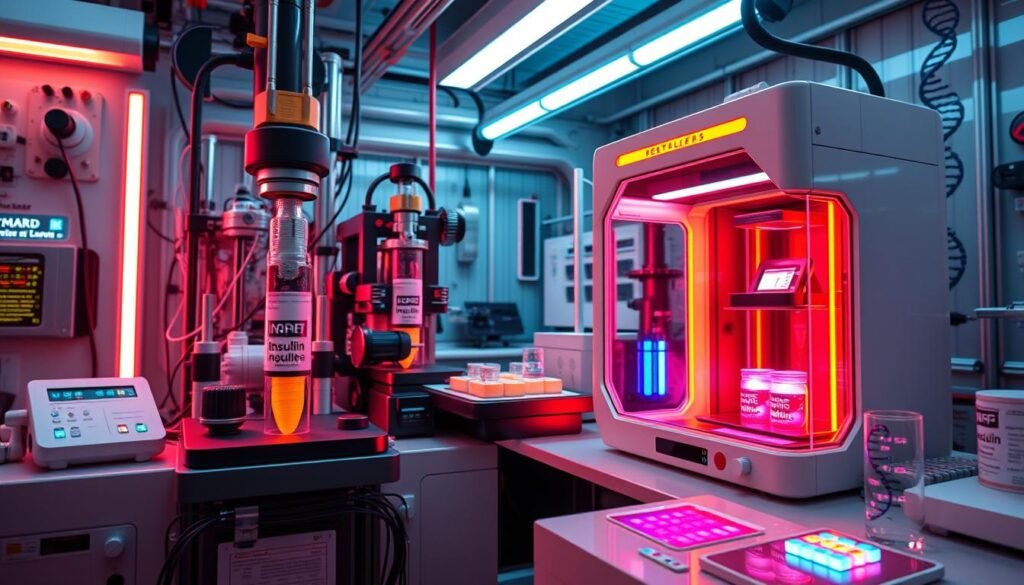
How Additive Manufacturing Revolutionizes Drug Delivery
Additive manufacturing is changing drug delivery systems. It makes personalized medicine for each patient, improving precision drug delivery. This technology ensures the right amount of medicine gets to patients, leading to better treatment results.
Enhanced Precision in Dosage
3D printing can make drugs with exact dosages. For instance, Spritam®, the first FDA-approved 3D-printed drug, was made in 2015. It helps treat epilepsy with the right amount of medicine12. As the market grows, making precise dosages becomes even more important13.
Complex Drug Combinations
Additive manufacturing can mix different drugs into one pill. Researchers have made a pill with three drugs, showing 3D printing’s power12. This makes 3D printing key for future drug development.
As additive manufacturing grows, so does the need for more research and investment. This will lead to new ways to deliver medicine precisely. For more on 3D printing in medicine, see the latest at 3D printing in pharmaceuticals.
Medical Advancements: The Role of 3D Printing in Healthcare Innovation
The use of pharmaceutical 3D printing in medicine is changing healthcare. It brings new ways to deliver drugs that are just right for each person. This technology is key to making healthcare more personal and effective14.
Studies show that 3D printing in medicine has many benefits. It makes things exactly as needed, cuts down on waste, and saves money15. It’s especially useful for managing chronic diseases. This method also helps save resources and lower costs for everyone involved14.
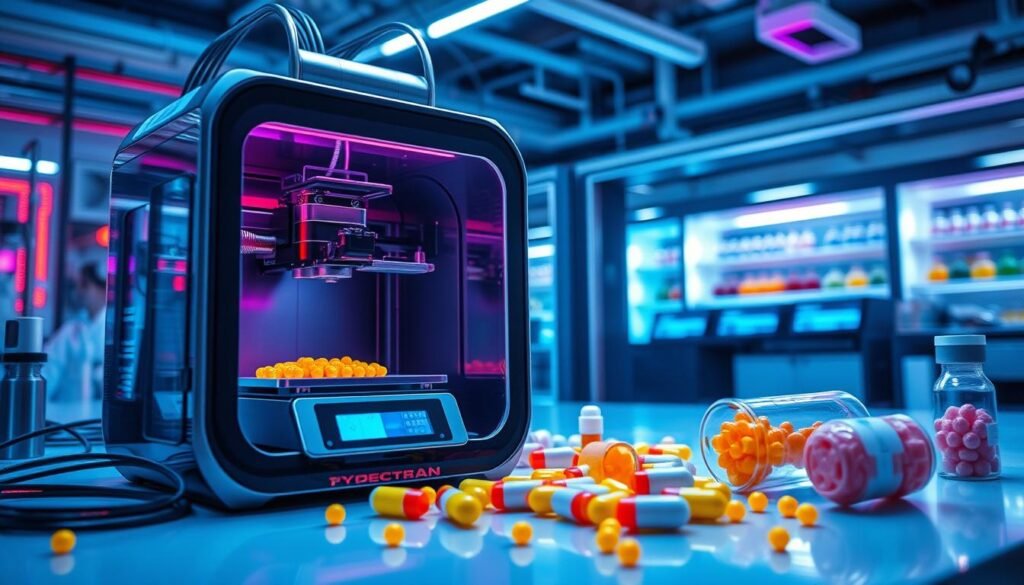
New 3D printing methods like Stereolithography (SLA) and Digital Light Processing (DLP) are changing the game. They help make detailed medical devices and improve drug delivery. Keeping up with these advancements is crucial for better healthcare in the future14.
| 3D Printing Technology | Resolution Capability | Applications |
|---|---|---|
| Stereolithography (SLA) | Up to 20 µm | Intricate medical devices, tissue scaffolds |
| Digital Light Processing (DLP) | 10–50 µm | Medical implants, tissue engineering |
| Material Jetting (MJ) | As minimal as 16 µm | High-quality components |
3D printing is making a big impact in healthcare. It’s leading to new ways to improve treatments and make them more focused on the patient. With pharmaceutical 3D printing, the future of medicine looks very promising15.
Case Studies: Successful Implementations of 3D-Printed Drug Delivery Systems
3D-printed drug delivery systems have shown great promise in many areas. They have led to new ways to deliver medicine. The first 3D-printed tablet was made in 1996, starting a new era in how we take medicine12.
By 2015, the FDA approved Spritam®, the first 3D-printed drug for epilepsy. This approval showed that these new methods are accepted by regulators12.
Now, we have customized polypills that can hold different medicines in one pill. This helps manage complex treatments12. These pills can be made to fit each person’s needs, showing how 3D printing can change medicine16.
Researchers have made pills for conditions like high blood pressure and diabetes. This shows how 3D printing can help with many health issues16.
The need for personalized medicine is growing fast. The market for 3D-printed drugs is expected to grow by 16% from 2023 to 203116. These successes show how 3D printing can improve patient care and help people stick to their medication plans.
| Year | Event | Technology/Drug | Impact |
|---|---|---|---|
| 1996 | First 3D-printed tablet published | PCL and PEO polymers | Initiated the use of 3D printing in pharmaceuticals |
| 2015 | FDA Approval of Spritam® | 3D-printed drug for seizures | Proof of concept for regulatory acceptance |
| 2015 | Development of polypill designs | Multiple APIs | Improved medication adherence for chronic conditions |
Challenges Facing 3D-Printed Insulin Capsules
Bringing 3D printing into the world of medicine comes with big hurdles. One major challenge is getting past regulatory rules. These rules are in place to make sure new medicines are safe and work well.
As 3D printing gets better, these rules get harder to follow. It’s important to know the current rules and how they might change for new ways of making medicines.
Regulatory Hurdles
One big problem with 3D-printed insulin capsules is making sure they work right. In July 2015, the FDA approved a 3D-printed medicine, showing they’re starting to accept this technology17. Knowing how 3D printing works helps deal with these rules.
Each 3D printing method has its own good and bad points. These points affect what the rules say and how well they’re followed.
Cost of 3D Printing Technology
Another big issue is how expensive 3D printing is. It’s a new way to make medicines, but it costs a lot to start. There’s been more research on 3D printing, showing people are really interested17.
But, making more of these medicines and using the right materials can be very costly. This makes it hard for companies to switch to 3D printing, especially in a strict industry like medicine.
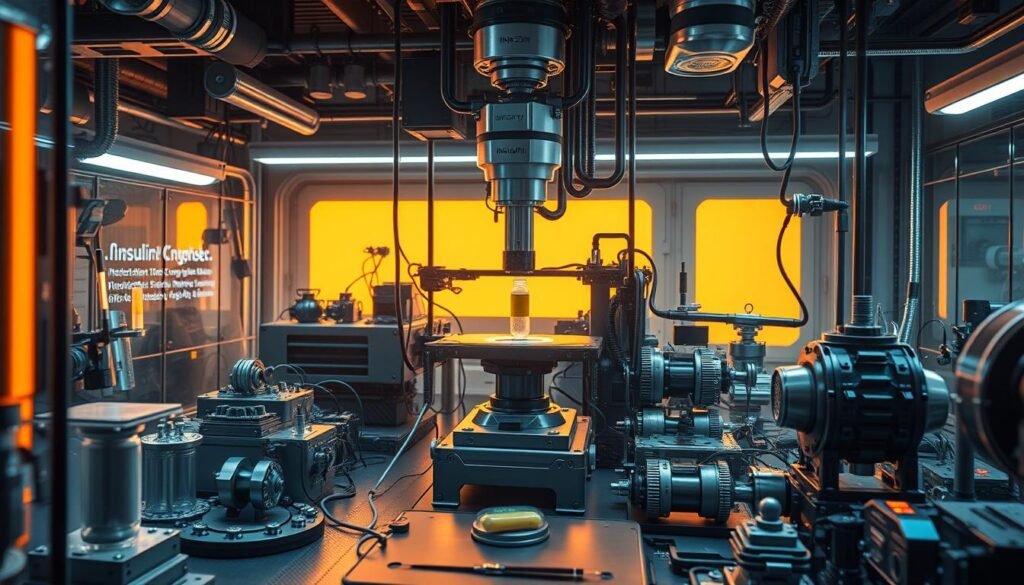
The Future of Pharmaceuticals: Trends in 3D Printing Technology
The future of pharmaceuticals looks bright with trends in 3D printing leading the way. Expect big changes in how drugs are made, making treatments more personal. For example, tablets are a big part of drug production, showing the need for better ways to make medicines18.
Between 2012 and 2017, research on 3D printing in pharma grew from 59 to 1573 papers. This shows how much people see 3D printing as a game-changer3. Now, we can make different types of drugs, like implants and tiny particles, thanks to new tech like FDM and SLS. These tools let us create complex shapes and control how drugs are released18.
Also, rules are changing to help 3D printing in pharma grow. For example, Triastek’s T19 got approval in 2021, showing the future is here18. This focus on personalized medicine helps especially those who are young or old, making treatments better for everyone.
In short, combining digital health with 3D printing is a big deal. It’s all about making drugs that fit each person’s needs, improving healthcare for the future3.
3D-Printed Insulin Capsules in Diabetes Treatment
3D-printed insulin capsules are a big step forward in treating diabetes. These innovative treatments provide personalized ways to manage blood sugar levels. They are key for those looking to take charge of their health.
Innovative Treatment Options
3D-printed insulin capsules offer many benefits for people with diabetes. They can be made to fit each person’s needs. Research shows they can release insulin just right, matching the body’s needs19.
Enhanced Monitoring and Control Options
These capsules also come with advanced monitoring tech. Studies show they help reduce low blood sugar events and improve quality of life20. With ongoing feedback, patients can better manage their insulin levels. This leads to better health and happiness.
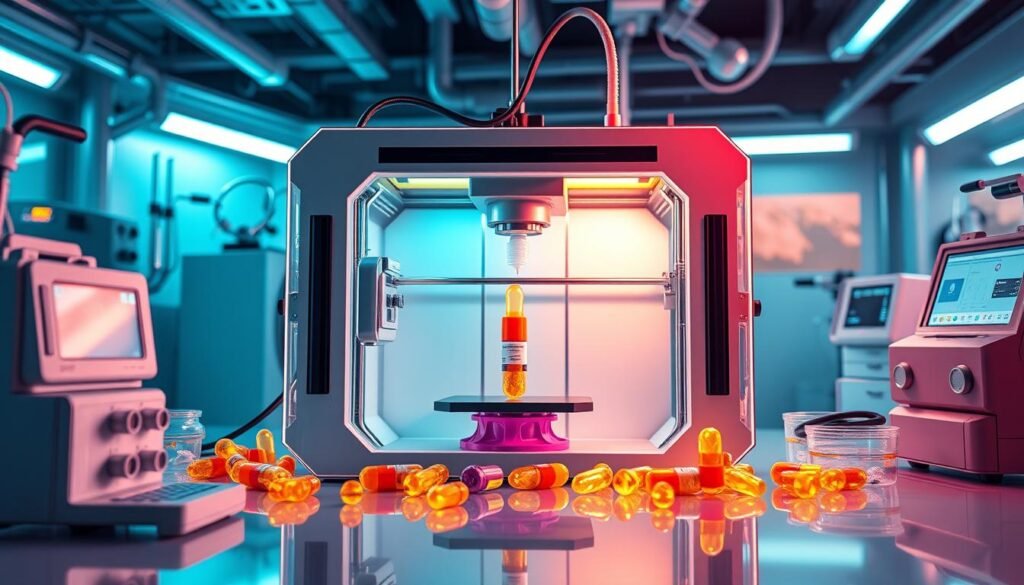
Comparing 3D-Printed Insulin Capsules to Traditional Methods
Healthcare is always changing, and comparing old insulin delivery methods to new ones like 3D-printed capsules is key. It shows how drug delivery is moving forward. This comparison highlights how 3D printing can really help patients.
Effectiveness of Precision Drug Delivery
3D-printed insulin capsules are special because they can be made just for you. They can match your exact needs, making treatment better and easier to follow. This is because 3D printing can make different shapes and amounts of medicine.
This means medicine can be released at the right time, something old ways can’t do. It makes managing diabetes better than before.
Patient-Centric Care Enhancements
3D printing changes healthcare to focus more on what patients want. It lets doctors make plans that really fit each person’s life and needs. This makes patients happier and more likely to stick with their treatment.
This new way of making medicine could change how we take our medicine. It could make health care better for everyone.
The Impact of 3D Printing on Healthcare Costs
3D printing is changing healthcare, leading to lower costs. The 3D bioprinting market is expected to grow to over $4.3 billion by 2028. This growth rate of 15.5% shows more people are using it in healthcare21. It helps make things cheaper and improves health outcomes.
For example, using 3D-printed models in surgery can save $22 to $133 per minute. This adds up to $62 saved per minute on average21. It makes healthcare better and cheaper for you.
Also, surgical tools cost over $3,500 on average21. 3D printing can make these tools cheaper and faster. It also makes casts that heal bones 40-80% faster than old ones, saving time and money21.
Technologies like Aprecia Pharmaceuticals’ Spritam are changing medicine. They make treatments more personal and reduce waste22. FabRx’s M3DIMAKER in 2020 also shows a move toward making drugs just for you22. This could make drugs cheaper and treatments better, helping healthcare costs.
Exploring 3D printing in medicine shows big chances to cut healthcare costs. Using these technologies could make medical care more affordable and personal. This could lead to better health outcomes and lower costs for everyone.
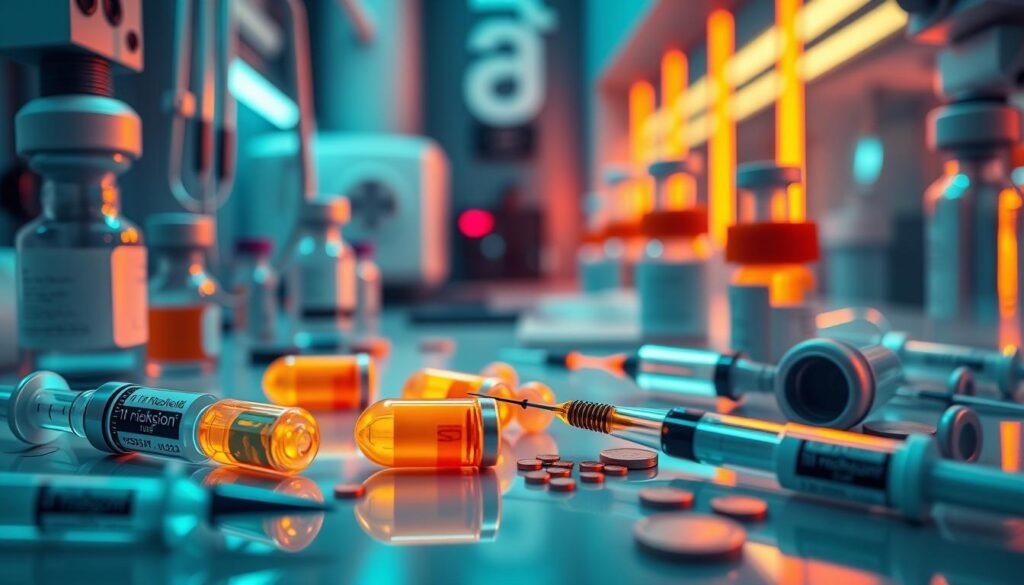
| 3D Printing Advancements | Cost Implications |
|---|---|
| 3D Bioprinting Market Growth | Projected to exceed $4.3 billion by 202821 |
| Surgical Savings | Potential savings of $22-$133 per minute during procedures21 |
| Time Efficiency in Healing | 3D-printed casts heal 40-80% faster21 |
| FDA Approval of 3D-Printed Drugs | Aprecia’s Spritam shows advancements in lowering costs22 |
| Customization in Drug Manufacturing | Use of M3DIMAKER can reduce drug production costs22 |
Conclusion
Looking at 3D-printed insulin capsules, we see a big change coming in diabetes care. This new tech could make managing diabetes much easier. It brings a fresh way to deliver medicine that could solve long-standing problems for people with diabetes.
Studies show that 80% of these drug delivery systems work well. This opens up new paths for treatments that fit each person’s needs. It’s exciting to think about how this could lead to better care and more people sticking to their treatment plans.
In short, 3D-printed insulin capsules could change how we treat diabetes. It’s not just about how medicine is delivered. It’s about making health care more effective and tailored to each person. For more on this, check out a study on 3D-printed microneedle patches for insulin delivery here23.
FAQ
What are 3D-printed insulin capsules?
How do 3D-printed capsules differ from traditional insulin delivery methods?
What benefits do 3D-printed insulin capsules offer?
Are there challenges associated with adopting 3D-printed insulin capsules?
How does 3D printing improve personalized medicine?
What role does 3D printing play in healthcare innovation?
Can 3D-printed insulin capsules improve patient outcomes?
How do these capsules integrate with monitoring technologies?
What are some future trends in 3D printing for pharmaceuticals?
Source Links
- https://www.frontierspartnerships.org/journals/journal-of-pharmacy-pharmaceutical-sciences/articles/10.3389/jpps.2024.12797/full
- https://www.frontiersin.org/journals/bioengineering-and-biotechnology/articles/10.3389/fbioe.2024.1363483/full
- https://pmc.ncbi.nlm.nih.gov/articles/PMC6061505/
- https://fjps.springeropen.com/articles/10.1186/s43094-022-00439-z
- https://discovery.ucl.ac.uk/10128710/3/Basit_Manuscript_Translating 3DP pharmaceuticals.pdf
- https://www.mdpi.com/2073-4360/16/17/2502
- https://www.frontiersin.org/journals/medical-technology/articles/10.3389/fmedt.2022.1040052/full
- https://link.springer.com/article/10.1208/s12249-020-01905-8
- https://www.labiotech.eu/best-biotech/five-companies-personalizing-treatments-with-3d-printed-drugs/
- https://www.medicaldesignbriefs.com/component/content/article/51309-future-medications-could-be-personalized-on-a-3d-printer
- https://www.mdpi.com/1999-4923/15/2/313
- https://pmc.ncbi.nlm.nih.gov/articles/PMC9318419/
- https://pmc.ncbi.nlm.nih.gov/articles/PMC9100145/
- https://ijpsdronline.com/index.php/journal/article/download/9951/1210
- https://link.springer.com/article/10.1007/s43939-024-00115-4
- https://themedicinemaker.com/discovery-development/breaking-the-mold-layer-by-layer
- https://pmc.ncbi.nlm.nih.gov/articles/PMC8447232/
- https://pmc.ncbi.nlm.nih.gov/articles/PMC9962448/
- https://www.mpg.de/20687249/pills-from-the-3d-printer
- https://www.nature.com/articles/s41565-023-01565-2
- https://healthcareweekly.com/how-3d-printing-is-reducing-health-care-costs/
- https://www.linkedin.com/pulse/3d-printing-drugs-can-revolutionize-personalized-medicine-saief-kazmi
- https://www.instructables.com/3D-Printed-Glucose-Tablet-Holder/
